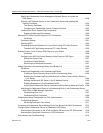
RealPresence Collaboration Server (RMX) 1500/1800/2000/4000 Administrator’s Guide
Polycom®, Inc. 28
● Configure the Collaboration Server to support Polycom third party and partner environments such as
Microsoft, IBM, Cisco, Avaya, Broadsoft and Siemens.
● Configure the Collaboration Server for special applications and needs by setting various system
flags.
● Manage and troubleshoot the Collaboration Server’s performance.
The Polycom RealPresence Collaboration Server (RMX) 1500/1800/2000/4000 Getting Started Guide
provides description of basic conferencing operations. It will help you perform the following tasks:
● Unpack the Collaboration Server system and install it on a rack.
● Connect the required cables to the Collaboration Server.
● Perform basic configuration procedures.
● Start a new conference and connect participants/endpoints to it.
● Monitor ongoing conferences
● Perform basic operations and monitoring tasks
The RealPresence Collaboration Server (RMX) 1500/2000/4000 Deployment Guide for Maximum Security
Environments provides a deployment methodology for system administrators implementing Maximum
Security Environments.
Who Should Read This Guide?
System administrators and network engineers should read this guide to learn how to properly set up
Polycom Collaboration Server systems. This guide describes administration-level tasks.
For detailed description of first time installation and configuration, description of the Collaboration Server
(RMX) Web Client, and basic operation of your Collaboration Server system, see the Polycom
RealPresence Collaboration Server (RMX) 1500/1800/2000/4000 Getting Started Guide.
Prerequisites
This guide assumes the user has the following knowledge:
● Familiarity with Windows® XP or Windows 7 operating systems and interface.
● Familiarity with Microsoft® Internet Explorer® Version 7, 8 or 9.
● Basic knowledge of video conferencing concepts and terminology.
How This Guide is Organized
The following typographic conventions are used in this guide to distinguish types of in-text information.
Typographic Conventions
Convention Description
Bold Highlights interface items such as menus, soft keys, flag names, and directories. Also used
to represent menu selections and text entry to the phone.
Italics Used to emphasize text, to show example values or inputs, file names and to show titles of
reference documents available from the Polycom Support Web site and other reference
sites.


















